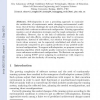QOSA
2010
Springer
14 years 1 months ago
2010
Springer
Self-adaptation is now a promising approach to maximize the satisfaction of requirements under changing environmental conditions. One of the key challenges for such self-adaptive s...
QOSA
2010
Springer
14 years 1 months ago
2010
Springer
Design decisions for complex, component-based systems impact multiple quality of service (QoS) properties. Often, means to improve one quality property deteriorate another one. In ...
QOSA
2010
Springer
14 years 4 months ago
2010
Springer
The use of redundant computational nodes is a widely used design tactic to improve the reliability of complex embedded systems. However, this redundancy allocation has also an effe...
QOSA
2010
Springer
14 years 6 months ago
2010
Springer
Critical properties of software systems, such as reliability, should be considered early in the development, when they can govern crucial architectural design decisions. A number o...
QOSA
2010
Springer
14 years 7 months ago
2010
Springer
Abstract. Software performance prediction methods are typically validated by taking an appropriate software system, performing both performance predictions and performance measurem...
QOSA
2010
Springer
14 years 7 months ago
2010
Springer
Using model-to-model transformations to generate analysis models or code from architecture models is sought to promote compliance and reuse of components. The maintainability of tr...
QOSA
2010
Springer
14 years 7 months ago
2010
Springer
In order to ensure the quality of their software development process, companies incorporate best practices from recognized repositories or from their own experiences. These best pr...
QOSA
2010
Springer
14 years 7 months ago
2010
Springer
Software performance engineering (SPE) enables software architects to ensure high performance standards for their applications. However, applying SPE in practice is still challengi...




